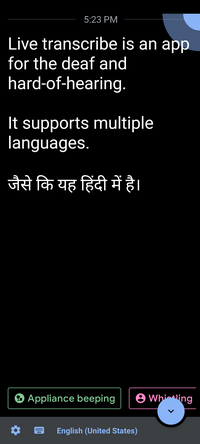Live Transcribe is a smartphone application to get realtime captions developed by Google for the Android operating system. Development on the application began in partnership with Gallaudet University.[2] It was publicly released as a free beta for Android 5.0+ on the Google Play Store on February 4, 2019.[3] As of early 2023 it had been downloaded over 500 million times.[4] The app can be installed from an .apk file by sideloading and it will launch, but the actual transcription functionality is disabled, requiring creation of an account with Google.
 A screenshot of Google Live Transcribe running on a Samsung Galaxy S20 | |
| Developer(s) | Google Research |
|---|---|
| Initial release | February 4, 2019 |
| Stable release | 6.6.602963593[1]
/ February 5, 2024 |
| Operating system | Android |
| Size | 4mb |
| Type | Accessibility |
| License | Open Source |
| Website | www |
Development
editResearchers Dimitri Kanevsky, Sagar Savla and Chet Gnegy at Google developed the app in collaboration with researchers at Gallaudet University,[5] an American university for the education of the deaf and hard of hearing. The app uses machine learning to generate captions,[6] similar to YouTube's auto-generated captions.[7]
Features
editThe app uses automatic speech recognition to generate live captions in over 80 languages with varying accuracy.[8][9] The app, which requires connection to the Internet to function, is available to download on the Google Play Store.
A later update to the app[10] displayed information on sounds such as clapping, laughter, music, applause, and whistling.[11]
In August 2019, Google made the code for Live Transcribe open-source.[12][13]
In May 2020, the app started supporting transcription in Albanian, Burmese, Estonian, Macedonian, Mongolian, Punjabi, and Uzbek, supporting 70 languages.[14]
In March 2022, the app was updated with support to transcribe offline, without Internet connection, so long as the appropriate language pack has been installed.[15] The offline mode is only available for devices with 6GB of RAM and certain Google Pixel devices.
References
edit- ^ "Live Transcribe & Notification APKs". APKMirror. Retrieved April 13, 2024.
- ^ "Meet the Deaf Developer Behind Google's Live Transcribe App". 2019-02-07. Retrieved 2021-01-23.
- ^ Dieter Bohn (2019-02-04). "Google Live Transcribe could be a big help for people who are deaf or hard of hearing". TheVerge.
- ^ "Live Transcribe & Notification". Google Play. Retrieved 2023-02-11.
- ^ "As ADA turns 30, tech is just getting started helping people with disabilities". 2020-07-27. Retrieved 2021-01-23.
- ^ "Real-time Continuous Transcription with Live Transcribe". Google AI Blog. Retrieved 2021-02-15.
- ^ "Google's Sagar Savla Built An App That Can Help 466 Million People Who Can't Hear Communicate". Times of India. 2020-01-06. Retrieved 2021-02-15.
- ^ Giridharan, Vignesh (2019-07-15). "Here's how Google is putting AI to work in healthcare, environmental conservation, agriculture and more | Digit". digit.in. Retrieved 2021-02-15.
- ^ Live Transcribe Team (2020-12-08). "Best Practices for Live Transcribe". Medium. Retrieved 2021-02-15.
- ^ Li, Abner (2019-06-03). "Live Transcribe update will recognize laughing, applause". 9to5Google. Retrieved 2021-02-15.
- ^ Li, Abner (2019-05-16). "Android Live Transcribe can detect farts, but it won't (for now)". 9to5Google. Retrieved 2021-02-15.
- ^ "Google open-sources Live Transcribe's speech engine". VentureBeat. 2019-08-16. Retrieved 2021-02-15.
- ^ "Bringing Live Transcribe's Speech Engine to Everyone". Google Open Source Blog. Retrieved 2021-02-15.
- ^ "Accessibility updates that help tech work for everyone". Google. 2020-05-21. Retrieved 2022-10-06.
- ^ "Google adds an offline mode to the Live Transcribe app". XDA. 2022-03-11. Retrieved 2022-10-06.